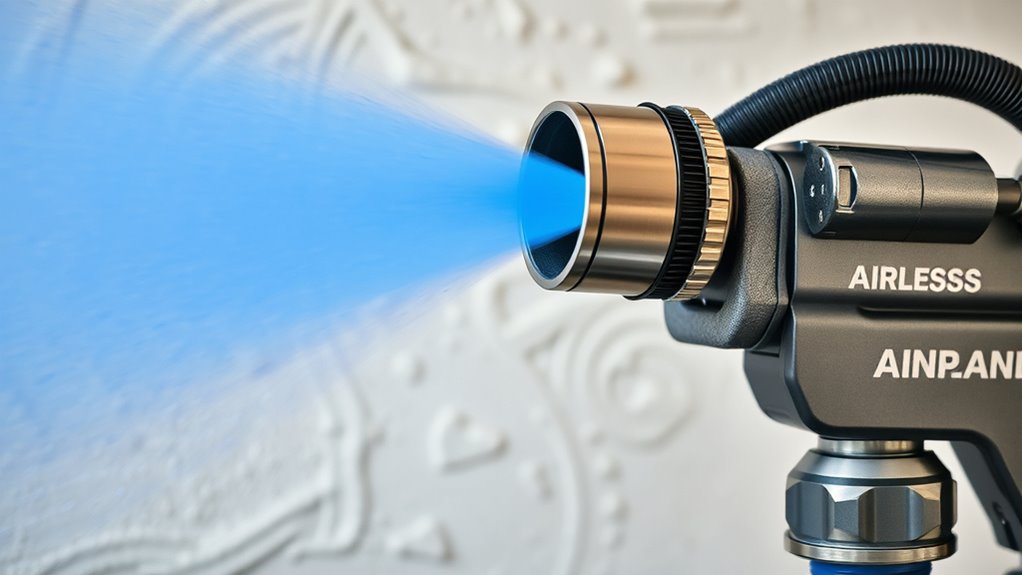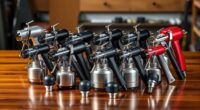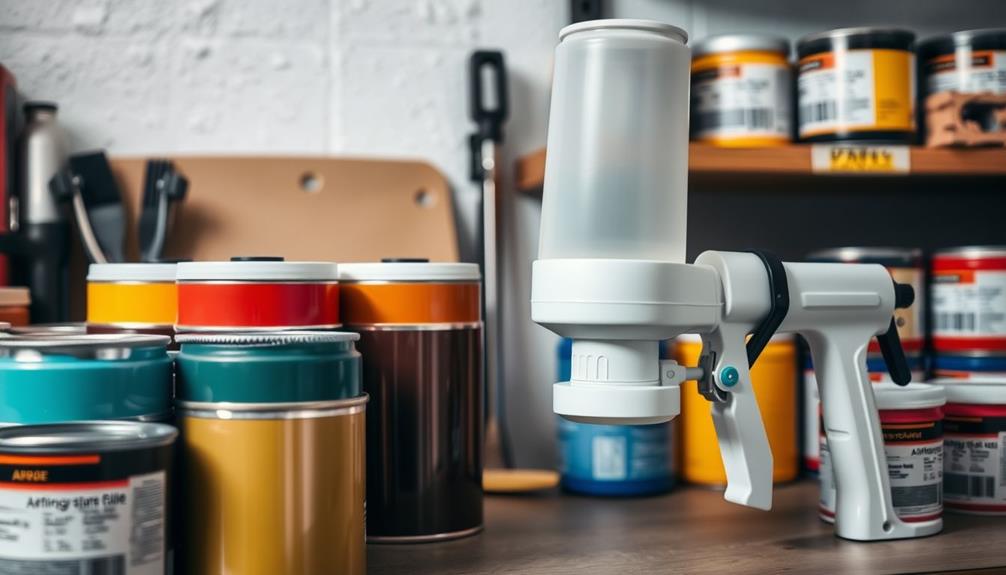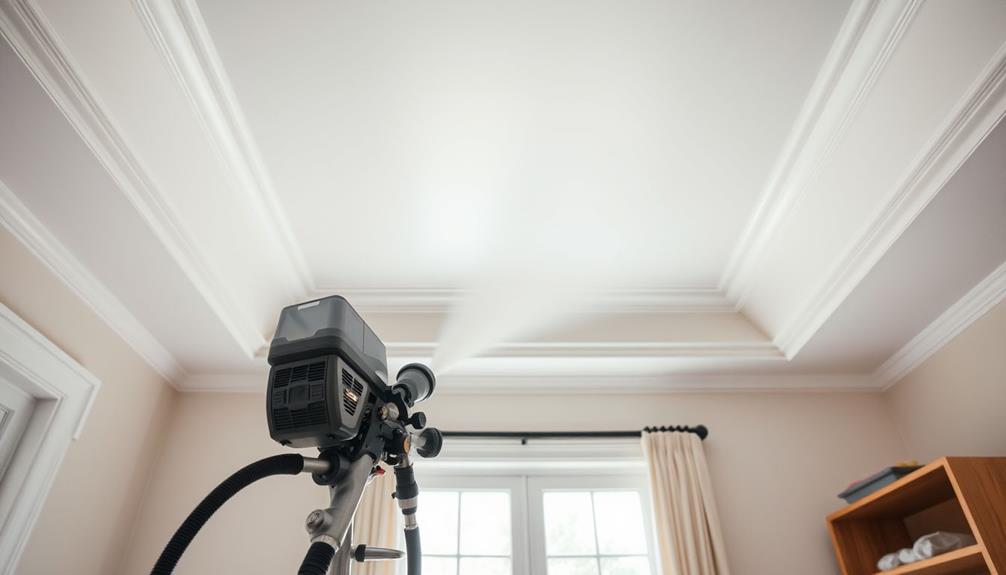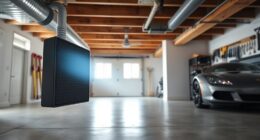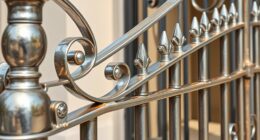An airless paint sprayer uses a high-pressure pump to atomize paint and spray it evenly onto surfaces. You hold a spray gun connected to a hose, and the machine pressurizes the paint for a smooth, fast application. It’s ideal for large projects, offering professional finishes with less overspray. To learn more about how each component works together and how to use it safely, keep exploring this guide.
Key Takeaways
- An airless paint sprayer uses high pressure to atomize paint for smooth, even application without the need for compressed air.
- It consists of a high-pressure pump, a spray gun, and a hose, which work together to deliver paint at consistent pressure.
- The pump pressurizes the paint, forcing it through a nozzle at high velocity to create a fine spray pattern.
- Suitable for large surfaces and heavy coatings like textured paints, offering faster coverage and professional finishes.
- Proper maintenance and safety precautions are essential for optimal performance and safe operation of the equipment.
Definition and Key Features of Airless Paint Sprayers

An airless paint sprayer is a powerful tool that uses high pressure to atomize paint and deliver a smooth, even coating on surfaces. Its key features include a high-pressure pump, a spray gun, and a hose, which work together to provide fast, efficient coverage. With the right paint sprayer accessories, you can customize the tool for various projects, making it versatile and user-friendly. These sprayers are known for reducing overspray and waste, which helps minimize their environmental impact. They are ideal for large-scale painting tasks, offering a professional finish in less time. Understanding these features allows you to select the right equipment, optimize your work, and contribute to eco-friendly practices by choosing models that are designed to limit environmental harm. Additionally, selecting efficient models can help reduce energy consumption, supporting sustainable practices.
Components and Design of an Airless Sprayer
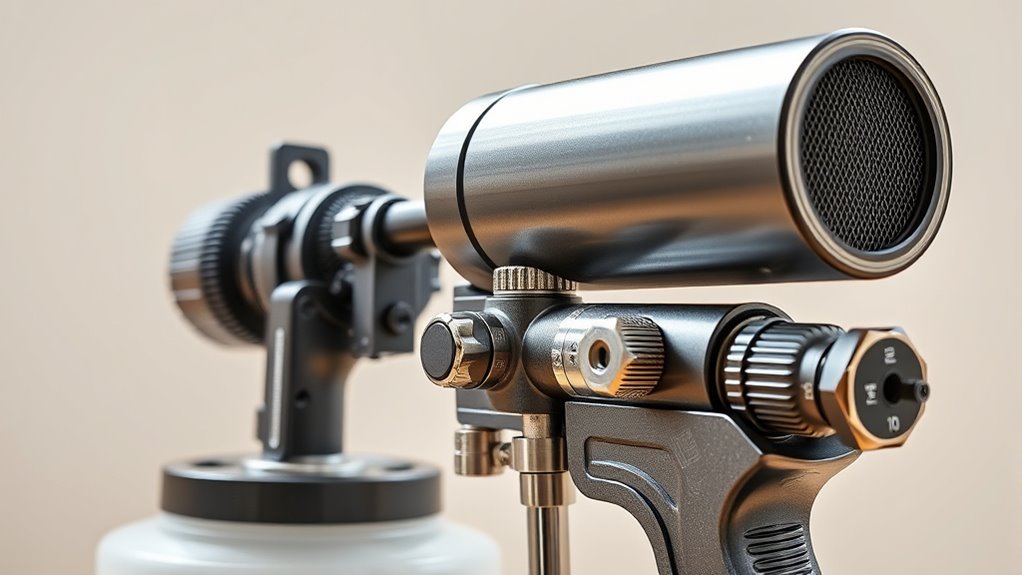
The design of an airless sprayer combines several essential components that work together to deliver efficient and high-quality paint application. At the core is the pump, which pressurizes the paint, pushing it through a hose to the spray tip. The spray tip, or paint nozzle, determines the spray pattern and flow rate, allowing you to control coverage and finish. Attached to the spray tip is the spray gun, which you hold and direct. Inside the gun, a trigger activates the flow of paint from the pump to the nozzle. The entire system is built to withstand high pressure, ensuring a smooth, even spray. Properly designed components make the sprayer reliable, easy to operate, and capable of delivering professional results every time. Additionally, the performance-enhancing features of a high-quality airless sprayer contribute to consistent and efficient painting, much like tuning modifications improve vehicle performance.
How Pressure Is Generated and Maintained
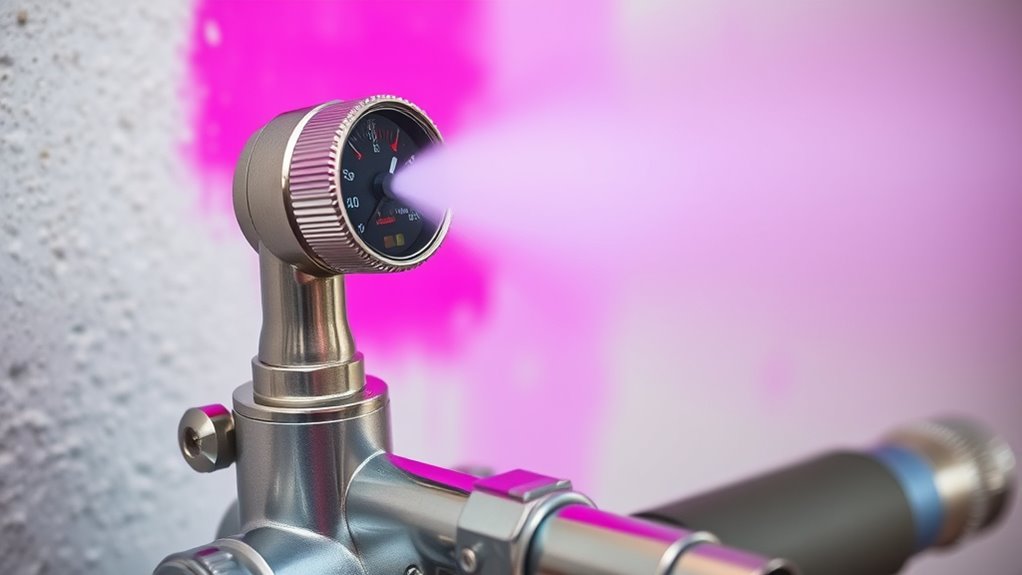
Pressure in an airless sprayer is generated primarily by the pump, which uses a motor or manual mechanism to force paint into a sealed chamber. As the pump mechanism operates, it creates high pressure that pushes paint through the hose and out of the spray tip. To maintain consistent spray patterns, pressure regulation components adjust the pressure levels, preventing fluctuations that can affect finish quality. These pump mechanisms are designed to deliver steady pressure, ensuring uniform application across surfaces. When you activate the sprayer, the pump continuously builds pressure until it reaches the set level, then maintains it during spraying. Proper pressure regulation is essential for ideal performance, helping you achieve a smooth, even coat without overspray or sputtering. Regular maintenance of pressure components ensures consistent pressure and optimal spray quality.
The Spraying Process Explained
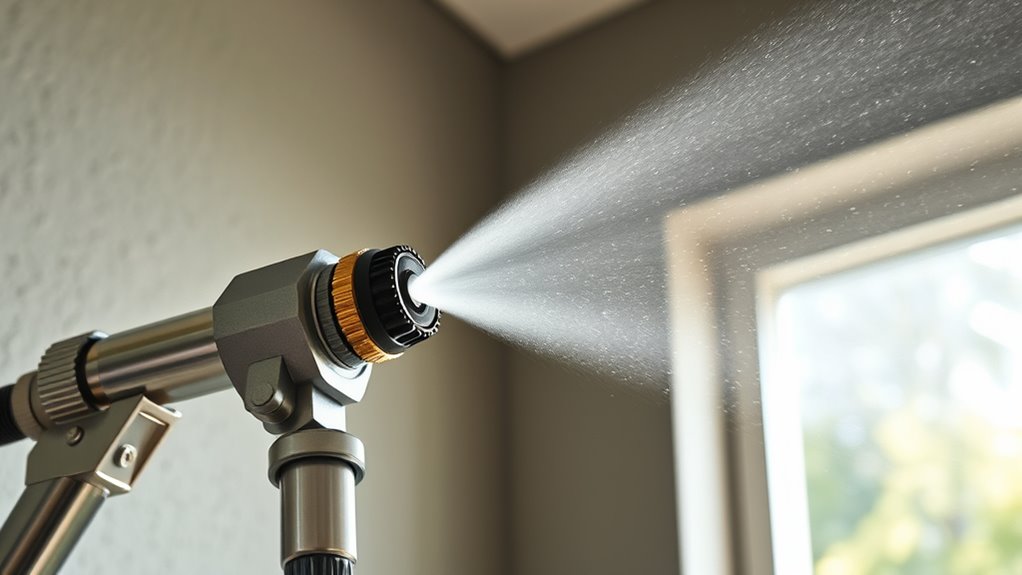
When you operate an airless paint sprayer, the pressurization mechanism pushes paint through a nozzle at high speed. This creates a consistent spray pattern that covers surfaces evenly. Understanding how pressure and spray formation work helps you achieve better, more professional results. Additionally, proper tuning of the sprayer can optimize performance, similar to how vehicle tuning enhances engine and handling characteristics performance tuning.
Pressurization Mechanism
To understand how an airless paint sprayer works, it’s essential to grasp its pressurization mechanism. Inside, a pump pressurizes the paint, forcing it through a hose to the spray tip. This process relies on pressure regulation to maintain consistent flow and prevent over-pressurization. Safety valves act as a safeguard, releasing excess pressure to protect you and the equipment. Proper maintenance of components like the filtration system ensures optimal performance and longevity of the sprayer.
| Component | Function |
|---|---|
| Pump | Creates high pressure for spraying |
| Pressure regulation | Ensures steady pressure to prevent surges |
| Safety valves | Release excess pressure for safety |
| Hydraulic chamber | Stores and maintains consistent pressure |
| Hose & nozzle | Delivers pressurized paint to the surface |
This system guarantees safe, efficient, and smooth operation during painting.
Spray Pattern Formation
Have you ever wondered how an airless paint sprayer achieves a uniform, even coating on surfaces? It all comes down to spray pattern formation. As you operate the sprayer, pressurized paint is forced through a tiny nozzle, creating a high-velocity stream. This stream breaks into a fine, atomized spray that covers the surface evenly. Unlike brush strokes, which can leave streaks or uneven textures, the spray pattern offers smooth, consistent coverage. The pattern’s shape and size depend on the nozzle and pressure settings, influencing how well colors blend and how seamlessly the paint coats different areas. By maintaining steady movement and proper technique, you can control the spray pattern to achieve professional-looking results, ensuring that your paint application is both efficient and visually appealing. Signs of spoilage in lemon juice, such as mold or off-smell, can help determine if the juice is still safe to use, and understanding storage duration is crucial for maintaining freshness.
Types of Coatings Suitable for Airless Sprayers
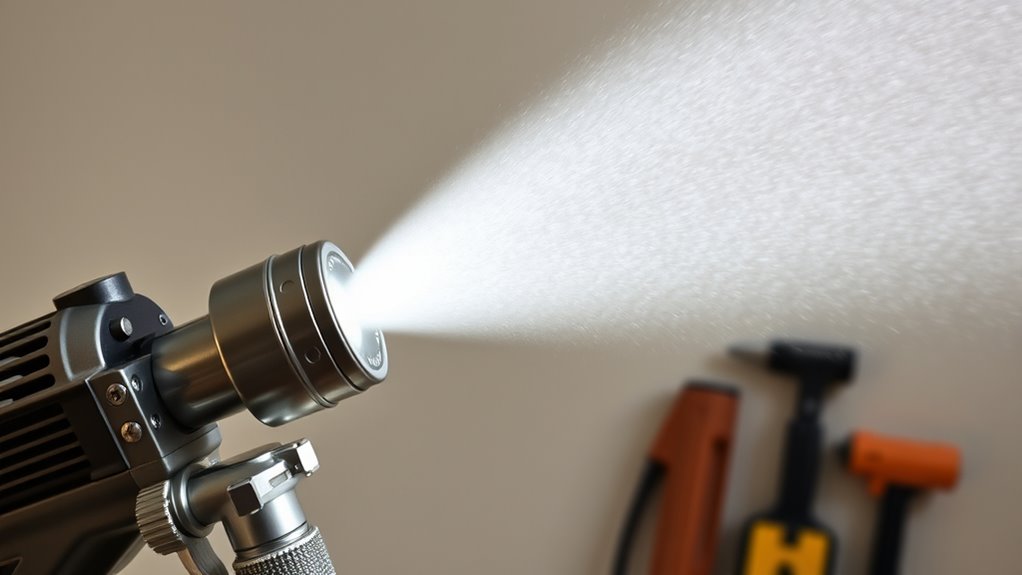
You can use airless sprayers with a variety of coatings, including latex and acrylics, which spray smoothly and evenly. Oil-based paints are also suitable, but they require proper ventilation and cleanup. For heavy coatings like textured or elastomeric paints, airless sprayers provide the power needed to achieve a consistent finish. Additionally, understanding the coating compatibility helps ensure the best results and longevity of your paint job.
Latex and Acrylics
Are latex and acrylic paints well-suited for airless paint sprayers? Yes, they are popular choices because of their versatility and quick-drying properties. These coatings generally have a suitable paint viscosity, allowing them to flow smoothly through the sprayer without clogging or splattering. When using latex or acrylics, your spray nozzle design becomes essential; a nozzle with the right orifice size ensures proper atomization and an even finish. Thinner paints with consistent viscosity help prevent issues like uneven spray or overspray. Keep in mind that these water-based coatings are easier to clean up and less odoriferous, making them ideal for indoor projects. Additionally, selecting the correct tip size is crucial for achieving a smooth, professional finish with these paints. Overall, latex and acrylic paints work efficiently with airless sprayers, provided you pay attention to paint viscosity and nozzle compatibility.
Oil-Based Paints
Oil-based paints are well-suited for airless sprayers because they provide durable, glossy finishes that cover surfaces smoothly. They’re ideal for projects needing a tough, long-lasting coat, such as trim or furniture. When using oil-based paints, your brush techniques can influence finish quality, but airless spraying offers a faster, more even application. Keep in mind that oil paints can be thick, so thinning may be necessary for proper spray flow. Additionally, color mixing with oil-based paints allows for vibrant, rich hues, but it’s important to mix thoroughly to avoid streaks. To highlight the benefits, here’s a quick comparison:
| Feature | Oil-Based Paints | Latex/Acrylics |
|---|---|---|
| Durability | High | Moderate |
| Finish | Glossy | Matte or semi-gloss |
| Application Ease | Moderate | Easy |
| Suitable for Sprayers | Yes | Yes |
Furthermore, the long-lasting nature of oil-based paints makes them a preferred choice for many exterior and interior applications requiring durability.
Heavy Coatings
Heavy coatings such as elastomeric paints, textured finishes, and thick primers are well-suited for airless sprayers because they deliver efficient, uniform coverage over large surfaces. When working with these coatings, you can achieve a smoother finish by adjusting your spray tip and pressure settings. To optimize application, consider these tips:
- Use proper brush techniques to smooth out edges and corners after spraying.
- Mix colors thoroughly to ensure consistent hue, especially when combining different shades.
- Practice even movement to prevent splattering and uneven layers, which is vital with thick coatings.
- Understanding cheating and its impact on trust can be crucial when working in team environments or managing projects requiring honesty and integrity.
Airless sprayers handle these heavy coatings efficiently, saving you time and effort while guaranteeing a professional-looking result. Proper preparation and technique are key to achieving the best finish.
Advantages Over Traditional Painting Methods
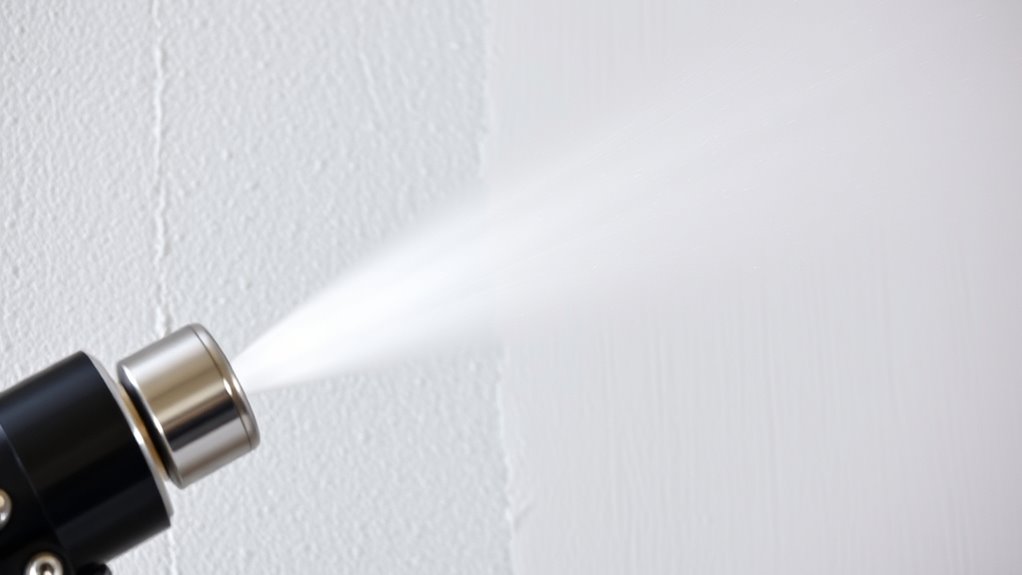
Airless paint sprayers offer significant advantages over traditional painting methods, making your projects faster and more efficient. They enable you to cover large surfaces quickly with a smooth, even finish, reducing the time spent on multiple coats. When it comes to painting techniques, sprayers provide better control over spray patterns and thickness, ensuring consistent results. Additionally, surface preparation becomes easier because you can reach into corners and textured areas more effectively than with brushes or rollers. You’ll spend less effort on prep work and cleanup, saving both time and materials. Furthermore, Mazda Tuning techniques can be applied to customize your vehicle’s appearance, just as you would tailor a painting project for optimal results. Overall, an airless paint sprayer streamlines the painting process, helping you achieve professional-quality results with less hassle and greater speed.
Safety Precautions and Handling Tips
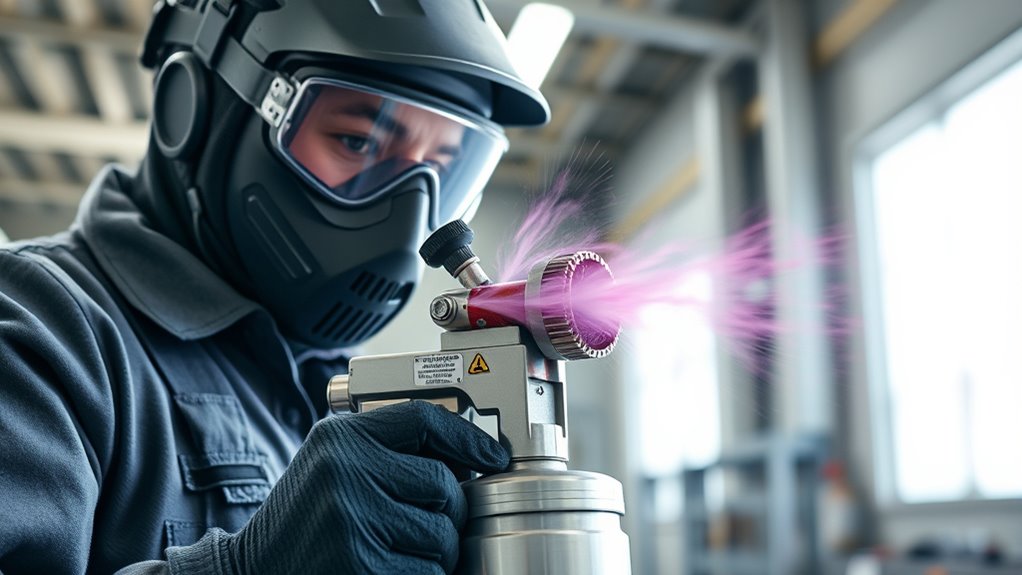
To guarantee safe and effective use of your airless paint sprayer, it’s essential to follow proper safety precautions and handling tips. First, always wear appropriate personal protective equipment, such as goggles, gloves, and a respirator, to protect yourself from paint fumes and splashes. Second, adhere to safe handling practices by keeping the sprayer upright, avoiding over-pressurizing, and ensuring proper grounding to prevent accidents. Third, work in a well-ventilated area to minimize inhalation of fumes and prevent buildup of flammable vapors. Additionally, disconnect the power and release pressure before cleaning or servicing the device. Proper air purifier maintenance is also crucial to ensure your equipment functions optimally and safely. Following these guidelines helps prevent injuries and ensures your painting project proceeds smoothly and safely.
Maintenance and Troubleshooting Common Issues
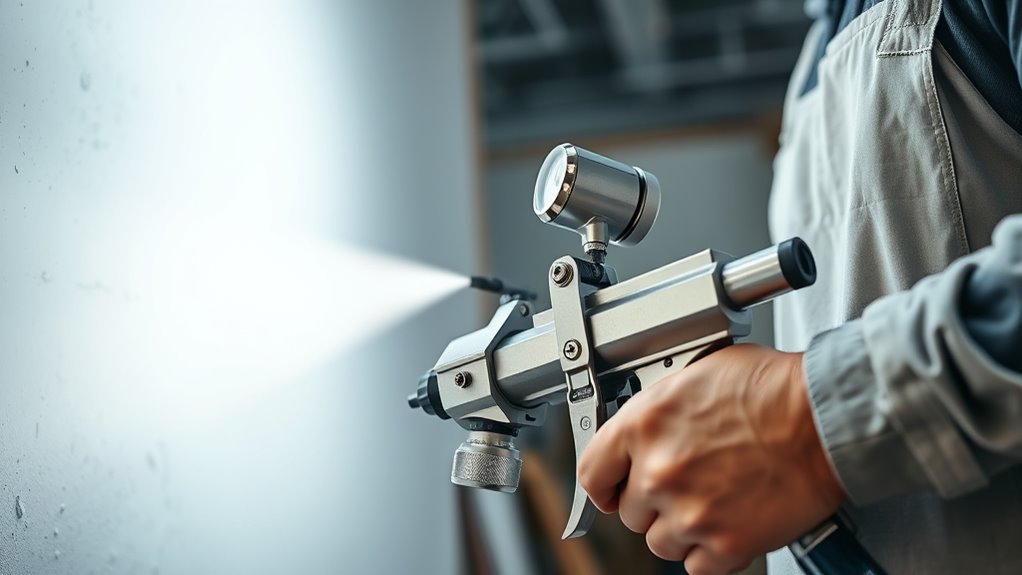
Regular maintenance and prompt troubleshooting are key to keeping your airless paint sprayer operating smoothly. Regular paint sprayer maintenance involves cleaning the spray tip, filters, and hose after each use to prevent clogs and buildup. If you notice uneven spray patterns or paint leaks, troubleshoot common issues like clogged nozzles or worn seals. Always check for proper pressure settings and ensure the paint isn’t too thick. If you encounter persistent problems, inspect the spray tip for damage or wear, and replace it if necessary. Keeping your equipment well-maintained reduces downtime and extends its lifespan. Being proactive with troubleshooting common issues helps you avoid bigger repairs and ensures consistent, high-quality results every time you use your airless paint sprayer. Additionally, Vetted – How Get Divorce tips can help you stay organized and stress-free during maintenance routines.
Applications and Best Uses for Airless Paint Sprayers

Because of their versatility and efficiency, airless paint sprayers are ideal for a wide range of projects, from residential to commercial. They excel in large-scale applications where speed and coverage matter. When choosing colors, you can easily handle multiple shades without switching tools, making color selection seamless. They’re perfect for exterior walls, fences, and decks, providing even coats and smooth finishes. For interior spaces, they save time and reduce mess. Additionally, airless sprayers help minimize environmental impact by reducing overspray and waste compared to traditional brushes and rollers. Use them for:
- Large exterior surfaces like siding and fences
- Commercial projects requiring fast coverage
- Interior walls with multiple color options
- Standardized communication ensures consistency and safety during application.
Their efficiency makes them the go-to choice for professional results while supporting eco-friendly practices.
Frequently Asked Questions
Can Airless Paint Sprayers Be Used for Staining or Varnishing?
Yes, you can use airless paint sprayers for staining or varnishing, but you should consider specific staining techniques and varnishing tips. They provide a smooth, even finish, making application easier and faster. Just adjust the pressure and nozzle for the best results, and be mindful of the material’s viscosity. Proper preparation and cleaning are essential to avoid clogging, ensuring your project looks professional and flawless.
What Is the Maximum Height or Distance an Airless Sprayer Can Reach?
Imagine aiming your sprayer at a towering wall, feeling the spray’s reach extend like a stream of water hitting high above. Your sprayer height determines its maximum reach, typically ranging from 15 to 30 feet, depending on the model and pressure settings. With the right equipment, you can comfortably cover tall surfaces, ensuring your sprayer’s maximum reach helps you paint or stain high areas without a ladder, saving time and effort.
How Do I Choose the Right Nozzle Size for Different Paints?
When choosing the right nozzle size, you need to take into account nozzle selection and paint viscosity. For thicker paints, opt for a larger nozzle to prevent clogging and ensure smooth flow. Thinner paints work better with smaller nozzles for finer finishes. Always match your nozzle size to your paint’s viscosity, and consult your sprayer’s recommendations to achieve the best results. Proper nozzle selection makes your painting easier and more professional-looking.
Are Airless Sprayers Suitable for Outdoor or Interior Projects?
You can use an airless sprayer for both outdoor and indoor projects, making your painting tasks faster and more efficient. Outdoors, it handles large surfaces like fences and decks, while indoors, it’s great for walls and ceilings. Remember to follow sprayer maintenance routines and safety precautions, like wearing protective gear and ensuring proper ventilation, to keep your project safe and successful.
What Are the Environmental Impacts of Using an Airless Paint Sprayer?
You might wonder about the environmental impacts of using an airless paint sprayer. While it reduces paint waste thanks to precise application, it can produce chemical emissions from solvents and paints, affecting air quality. Proper disposal of leftover paint and using eco-friendly products can minimize these impacts. So, by being mindful of emissions and waste, you help protect the environment during your painting projects.
Conclusion
Now that you understand how an airless paint sprayer works, imagine effortlessly transforming any surface with precision and speed. With the right technique, you’ll master smooth, even coats that leave a flawless finish. But beware—knowing the ins and outs is just the beginning. As you dive deeper, you’ll discover how to unleash its full potential, turning every project into a masterpiece. Are you ready to take your painting skills to the next level?
